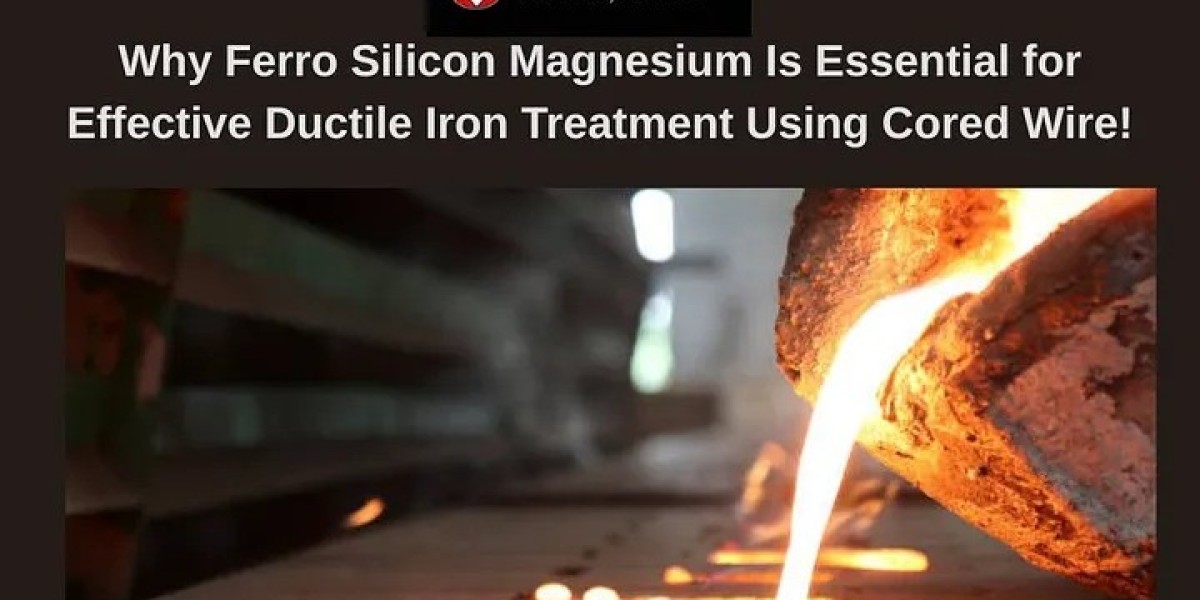In the world of metallurgy, producing high-quality ductile iron is a critical step in meeting the demands of modern engineering. From automotive components to heavy machinery, ductile iron plays a vital role due to its strength, flexibility, and durability. But behind every strong casting is a precise treatment process — and at the heart of that process are Ferro Silicon Magnesium (FeSiMg) and cored wire feeding.
Understanding Ductile Iron and Its Treatment
Ductile iron, also known as spheroidal graphite iron, is a type of cast iron known for its excellent mechanical properties. Unlike gray cast iron, which has flake-like graphite, ductile iron features graphite in a spherical form — giving it added toughness and elongation.
But this graphite shape doesn’t form naturally. It’s the result of a controlled nodularization process, where additives like magnesium are introduced into molten iron. That’s where fesimg comes into play.
Role of FeSiMg Alloy
FeSiMg is an alloy made from ferrosilicon, magnesium, and sometimes rare earth elements. It’s specifically designed for use in the nodularization (or spheroidization) of ductile iron. When added to molten metal, it alters the graphite structure from flakes to spheroids — giving the iron its ductile properties.
Key Benefits of Ferro Silicon Magnesium:
Promotes spheroidal graphite formation
Increases mechanical strength of castings
Improves impact resistance and ductility
Enhances machinability and surface finish
Enables consistent and repeatable treatment results
The Role of Cored Wire in Iron Treatment
Traditionally, magnesium was added to iron through ladle or sandwich methods, but these older techniques had drawbacks like metal loss, inconsistent absorption, and safety risks. Enter Cored Wire Injection — a modern, automated, and more controlled approach to alloying.
Cored wire is a tubular wire filled with specific treatment agents — in this case, fesimg. During treatment, the wire is injected directly into the molten iron through a feeding system. As it melts inside the metal, the magnesium reacts precisely, forming spheroidal graphite.
Advantages of Using Cored Wire:
Better control over magnesium content
Reduced magnesium fume emissions
Improved alloy recovery rates
Less slag formation and cleaner melts
Safer, more efficient operations
Why Ferro Silicon Magnesium + Cored Wire = Success
Here's why this combination works so well:
1. Precision and Consistency
The cored wire feeding method allows for accurate placement and dosage of ferro silicon magnesium in the melt. This consistency ensures uniform graphite nodules across the casting — essential for quality control.
2. Improved Recovery Rates
Magnesium is volatile and reactive. When added in open ladles, much of it can be lost to the atmosphere. Cored wire feeding reduces these losses, increasing the magnesium recovery rate and making the treatment more cost-effective.
3. Cleaner Metallurgy
Ferro silicon magnesium, when injected via cored wire, produces less slag and fewer impurities. This results in cleaner metal, improving casting quality and reducing defects.
4. Safety and Speed
Manual addition of magnesium alloys is risky due to its reactive nature. The cored wire system is safer and faster, reducing labor exposure and increasing throughput.
Applications in Industry
Industries that demand high-performance components rely on ductile iron treated with fesimg. Some common sectors include:
Automotive: Engine blocks, crankshafts, suspension part
Construction: Pipes, valves, and structural castings
Agriculture: Machinery parts and tools
Railways: Brake systems, wheels, and couplings
General Engineering: Pumps, gears, housings, etc.
Conclusion
The combination of ferro silicon magnesium and cored wire injection is a proven and essential approach to achieving high-quality ductile iron. It not only enhances the metallurgical properties of the iron but also streamlines the production process with precision, safety, and efficiency.
For foundries and manufacturers aiming for excellence, adopting this method is more than just an upgrade — it’s a necessity. With the rising demand for reliable and strong cast components, the importance of proper Ductile Iron Treatment has never been greater.
#FerroSiliconMagnesium, #DuctileIronTreatment, #CoredWireInjection










